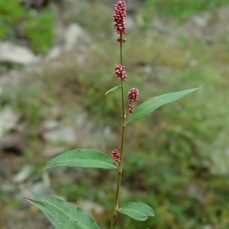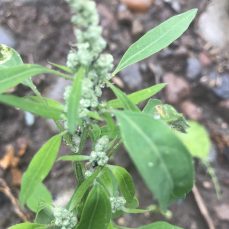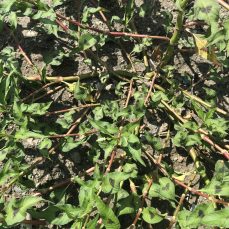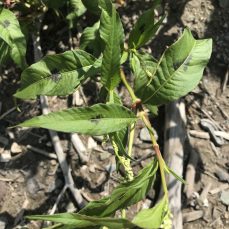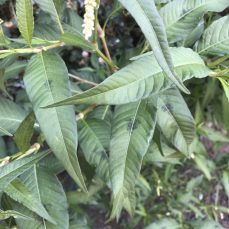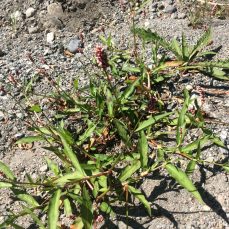
Management Category
Squamish
Whistler
Pemberton
Vectors of Spread
Synonyms
- Smartweed
- Jesusplant
- Redshank
- Spotted lady’s thumb
- Polygonum persicaria
ID Characteristics
General: Lady’s thumb is an annual weed from the buckwheat family (Polygonaceae).
Flowers: Individual flowers are small, bell-shaped and white, pink or purple. Together, they form dense, terminal spikes at the end of stems.
Stems: Are erect and 15 – 60 cm tall. Stems are light green, round and glabrous (smooth) or slightly pubescent (hairy). The nodes are usually red and brown; stems will turn more red towards the winter.
Leaves: Are alternate and lance-shaped, with a thin papery sheath and hairs at the base. They are marked by a dark green or reddish blotch, similar to a fingerprint, hence its common name.
Fruit: Lady’s thumb produces dry seeds that are disc-shaped to 3-sided. Their black or brown surface is smooth.
Roots: Lady’s thumb produces a shallow taproot. The root system does not produce rhizomes.
Similar Species
Native

Fireweed (Epilobium angustifolium) has similar leaves and red stems when immature, but it is taller (1-3 m), has showy pink flowers and no “thumbprint”.
Invasive

Himalayan knotweed (Persicaria wallichii) can look like lady’s thumb when it first emerges because of its leaf shape. However, the latter is much taller (1-2m), and its flowers are plume-like.
Habitat and Origin
Lady’s thumb is native to Europe and Asia. It was first identified in North America in 1843, yet the source of its introduction remains undetermined.
This species prefers full or partial sun and moist, rich conditions. It is often found near disturbed marshy areas or wetlands. However, it can adapt to grow in poor light and soil conditions. As such, it may also inhabit roadsides, meadows, vacant lots, gardens and railways.
How it Spreads
Lady’s thumb is an annual plant; the plant goes from seed to seed in one growing season. The seeds are its primary mode of reproduction, and they can remain viable in the soil for up to 45 years.
Seeds are commonly transported by birds. Lady’s thumb seeds may also contaminate commercial grains, which contributes to its spread. Floods can also cause it to travel great distances. Lastly, lady’s thumb is sometimes sold for wildflower gardens, which also aids its spread.
Impacts
Health:
- The plant contains chemicals that can cause skin irritations and allergic reactions.
Ecological:
- Reduces biodiversity.
- Leads to habitat loss for native flora.
Economic:
- Reduces crop yields and harvesting efficiency.
- Threatens agricultural, wetland, and lake landscapes.
- Host of agricultural pests like black root rot and tomato black ring virus.
Prevent the Spread
Lady’s thumb is widespread in the Sea to Sky region, and site-scale control options are either ineffective or futile. While lady’s thumb is not included in SSISC’s control programs, we recommend avoiding its cultivation.
Learn to identify lady’s thumb: use the images on this page to learn how to identify lady’s thumb.
What to do if you spot it: You can report any lady’s thumb sighting by visiting our reporting page.
DO:
- Regularly monitor properties for weed infestations.
- Ensure soil and gravel are uncontaminated before transport.
- Check wildflower mixes to ensure that they do not contain lady’s thumb.
DO NOT:
- Unload, park or store equipment or vehicles in infested areas; remove plant material from any equipment, vehicles or clothing used in such areas and wash equipment and vehicles at designated cleaning sites before leaving infested areas.
- Plant lady’s thumb in a garden, no matter how well-contained its enclosure may seem.
- Move soil that has been contaminated with lady’s thumb.
- Compost lady’s thumb!
Control
Mechanical
- Cultivation and hand-pulling can help control smaller infestations, as long as it is done before the seeds form.
- Gloves are recommended for hand-pulling, due to the risk of skin irritation.
- Additionally, improving the drainage of an area may discourage lady’s thumb from re-establishing.
- Tillage and cultivation may also be effective because they disrupt seedlings, but these methods will likely need to be continued long-term, because of the potential presence of a seed bank.
Chemical
- Lady’s thumb can quickly develop resistance to herbicides. Thus, many sources dissuade the use of chemical control.
- Non-selective, contact herbicides such as dicamba, 2,4-D and glyphosate are effective, as have systemic herbicides that kill the fibrous roots.
- We recommend that any herbicide application is carried out by a person holding a valid BC Pesticide Applicator Certificate. Before selecting and applying herbicides, you must review and follow herbicide labels and application rates; municipal, regional, provincial and federal laws and regulations; species-specific treatment recommendations, and site-specific goals and objectives.
Biological
There is no known biocontrol available for this plant.
Sea to Sky Distribution
Lady’s Thumb Factsheet
Having trouble viewing the factsheet? Don’t worry, all the information is included on this page. You can also contact us with any questions.
References
- Burke Herbarium Image Collection, Persicaria maculosa
- Centre for Agriculture and Bioscience International (CABI), Persicaria maculosa (redshank)
- Dave’s garden, Lady’s Thumb
- Edible Wild Food, Lady’s Thumb
- Electronic Atlas of the Flora of British Columbia, Persicaria maculosa Gray
- Farms Field Guide, Lady’s Thumb
- Flora of North America, Persicaria maculosa
- Illinois Wildflowers, Lady’s Thumb
- Invasive Species Compendium (CABI), Persicaria maculosa (redshank)
- Minnesota Wildflowers, Lady’s Thumb
- Native Plant Trust, Lady’s Thumb Smartweed
- Ontario Ministry of Agriculture, Food, and Rural Affairs, Lady’s Thumb
- Tennessee Invasive Plant Council, Polygonum persicaria L.
- University of California Agriculture and Natural Resources, Ladysthumb
- US Geological Society, Spotted Ladysthumb






